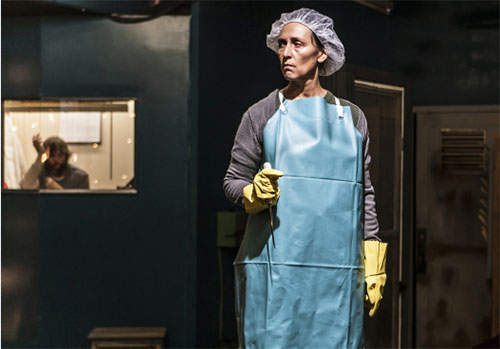by Suzy Evans
Rachel Hauck drew the line at live chickens.
Director Lisa Peterson wanted “at least three” birds to create the authenticity of a poultry factory, where South American immigrant women work in Lisa Ramirez’s play To the Bone. However, Hauck knew she could create that environment without a real animal in sight.
“What we chose to represent instead were the coops,” says Hauck, a go-to downtown set designer known for her abstract and experimental work. “So the room is surrounded in layers and layers of coops. When those become alive, you really feel the birds.”
That room would be the Cherry Lane Theatre’s studio, where the show runs through Oct. 4. The production is part of the second annual Theater:Village, in which four West Village companies—Axis, Cherry Lane, New Ohio, and Rattlestick—present plays united by a common theme. This year’s festival, E Pluribus, focuses on diversity in America, with To the Bone following the brutal conditions its characters endure both professionally and personally.
Peterson and producer Angelina Fiordellisi were originally planning to stage the show next door on the Cherry Lane’s mainstage, but when that space became unavailable, Hauck had to overhaul her entire design concept.
“This whole thing is a rule breaker,” she says, noting that this is her first time dismantling a space for a show. “They’ve given me the incredible opportunity to really take over this room and turn it inside out. To get a theatre in New York to agree to do what we’ve done to this theatre is extraordinary.”
And take it over she has. The intimate studio space, which usually boasts a tiny stage and 60 stadium-style folding seats, is unrecognizable. Hauck pulled out the original stage, which had been in place for more than 10 years, and turned the platforms into audience risers on three sides of the room.
With the original seats folded up, Hauck covered them with wood paneling to create the exterior of a character’s house. Meanwhile, the stage manager’s booth became an office in the factory and the men’s dressing room transformed into a kitchen. Hauck also ripped up the floor, leaving the ground level enough to let one of the characters ride a skateboard. There’s even a real bathroom behind the booth-turned-office that is used by the actors during many critical moments of the play.
Finally, there are coops behind the audience, underneath the house, and in the center of the room, where they serve as seats in both a house and a car.
“We’ve built an extraordinary amount for this, but we’ve also taken advantage of what’s here,” says Hauck, adding that as part of her process she builds “appallingly accurate” models of the space before she begins her design. “You have to really understand the room to figure out what to put in it.”
One reason for the many locations around the space is that Ramirez’s play moves cinematically: There are nine locations just in scene one. The actors rehearsed in the room for two weeks without the set just to get a feel for how to move from one scene to the next, and Hauck applauds lighting designer Russell H. Champa’s work in using the existing lights and a series of practicals—like fluorescents for the factory and Christmas lights for a character’s backyard—to really define the different playing areas.
To give all these elements a sense of accuracy, Hauck relied on online research. “You can’t really get into those factories,” she says. “We found pretty extensive visual research, which of course is brutal.” She also watched the documentary Mississippi Poultry, but even without firsthand experience in that world, Hauck has found the authenticity her own way.
“It feels so real,” she says. “My favorite little detail in that kitchen is the mousetrap. It’s totally right for both the theatre and the house.”
—
Suzy Evans is a writer and editor based in New York City
Photos by Monique Carboni
